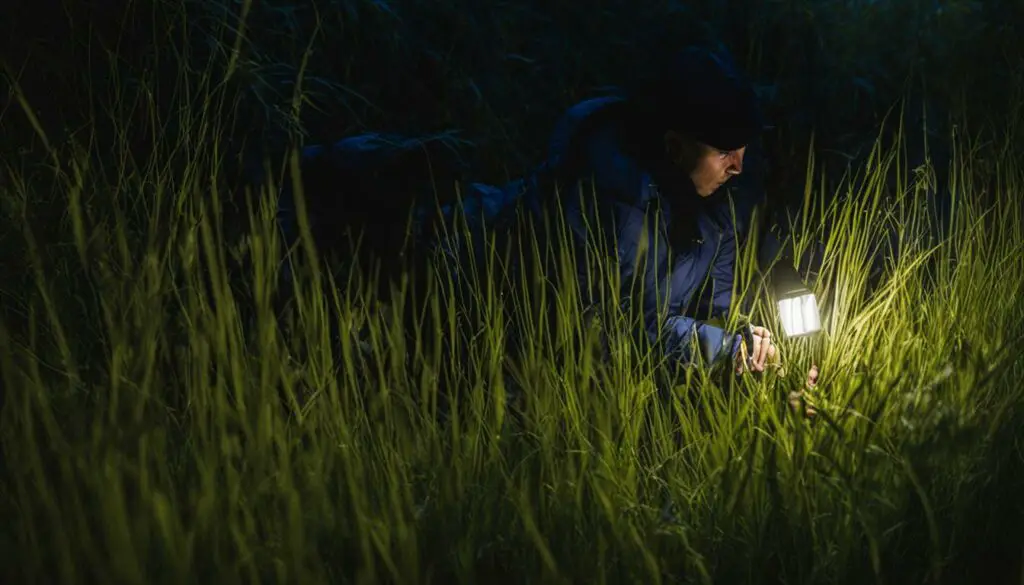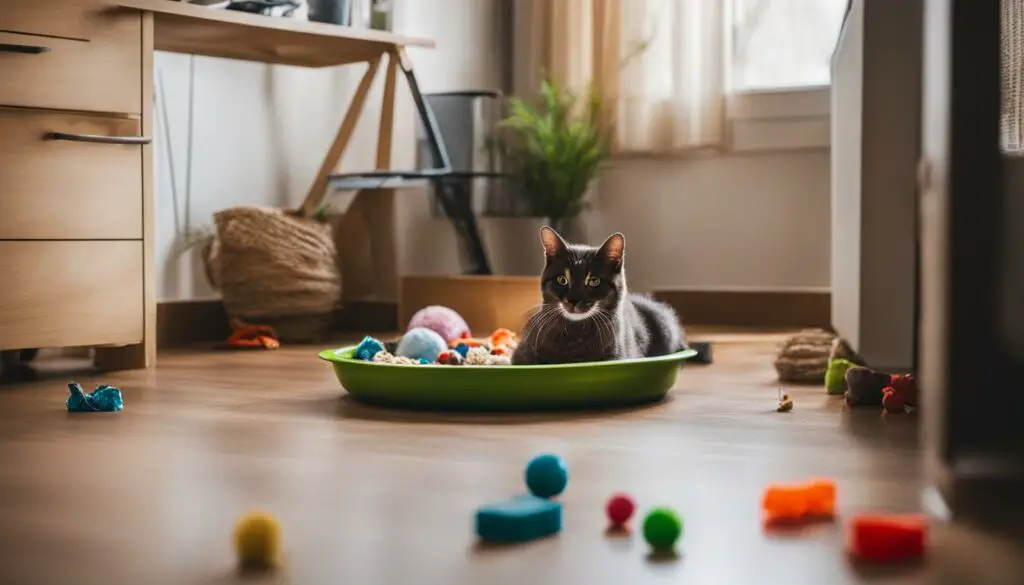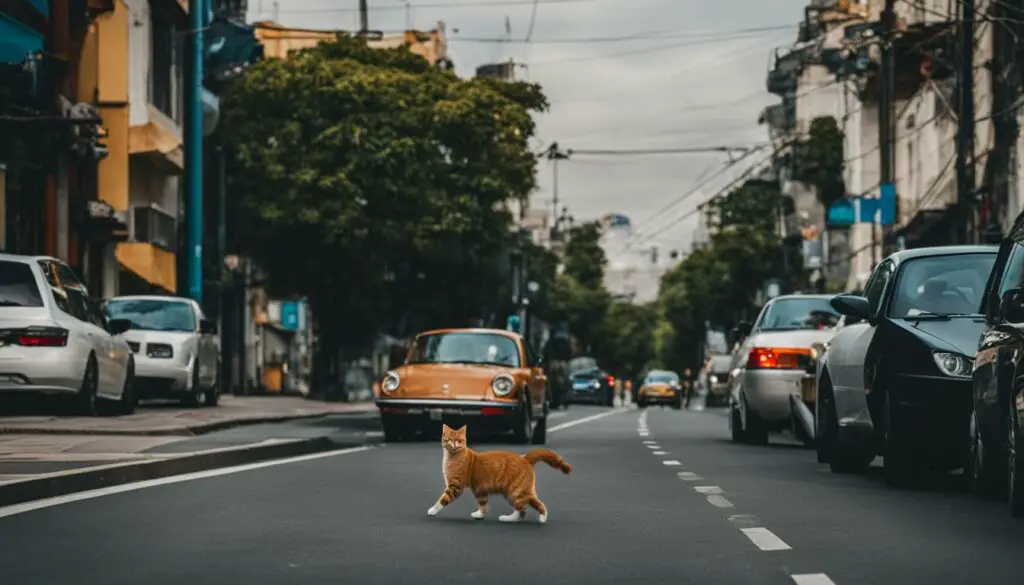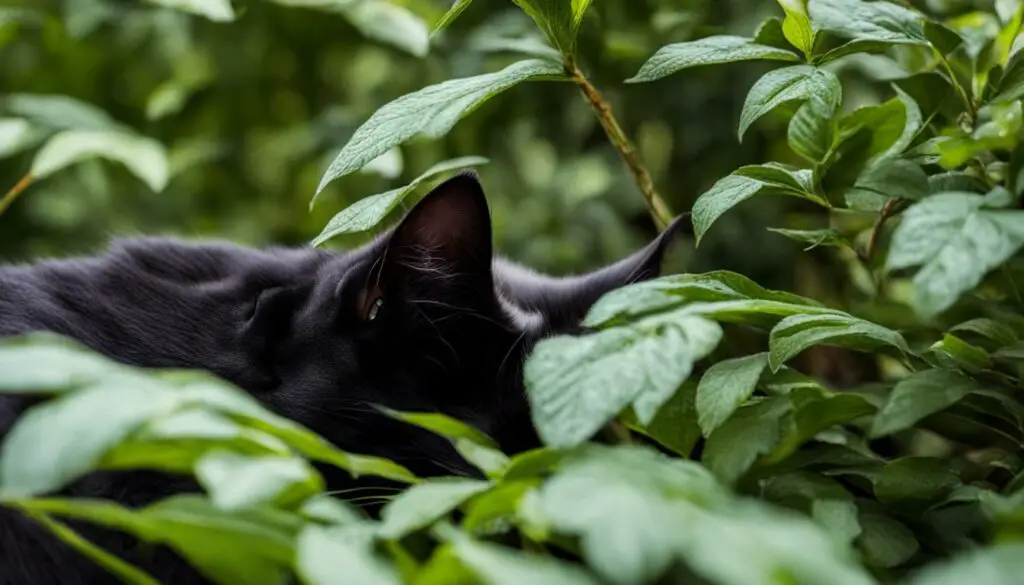Losing an indoor cat can be a distressing experience for any pet owner. When your beloved feline companion goes missing for 24 hours or longer, it’s natural to feel anxious and worried. But fear not, as this comprehensive exploration will guide you through the steps to take and provide expert advice to help ensure a safe return for your precious indoor cat.
With insights from professionals and cat owners who have experienced similar situations, you’ll gain valuable knowledge on how to stay calm, proactive, and focused during this challenging time. By understanding the reasons behind indoor cats going missing and implementing effective search strategies, you can increase the chances of finding your furry friend and bring them home where they belong.
Key Takeaways:
- Stay calm and take proactive steps when your indoor cat goes missing for 24 hours or longer.
- Understanding the reasons why indoor cats go missing can help guide your search efforts.
- When indoor cats are lost for a week, they may become scared and hide in unfamiliar places.
- Take action and remain persistent in your search efforts after a week of your cat being missing.
- Adjust your search strategies based on weather conditions and enlist the support of the community.
Why Do Indoor Cats Go Missing?
Indoor cats may go missing for various reasons, each driven by their unique behavior and instincts. Understanding these reasons can help us better navigate the situation and improve our chances of finding our missing feline friends.
Curiosity: Cats are naturally curious creatures, and their inquisitive nature can sometimes lead them to venture outside. The allure of new sights, sounds, and smells can be irresistible, prompting them to explore the world beyond their indoor environment.
Fear or Stress: Cats can become frightened or stressed by sudden loud noises, unfamiliar visitors, or changes in their environment. These feelings of anxiety may cause them to seek refuge outside, away from their perceived source of distress.
Accidental Escape: Despite our best efforts to keep our indoor cats safe, accidents happen. A door left open or a momentary lapse in vigilance can provide an opportunity for our feline companions to slip out unnoticed. Once outside, their natural instincts may kick in, making it challenging for them to find their way back home.
Unfamiliarity with the Outdoors: Indoor cats are accustomed to the comforts and predictability of their indoor environment. Venturing into the great outdoors exposes them to unfamiliar territory, which can disorient them and make it difficult for them to navigate their surroundings.
| Reasons Why Indoor Cats Go Missing |
|---|
| Curiosity |
| Fear or Stress |
| Accidental Escape |
| Unfamiliarity with the Outdoors |
While the reasons for indoor cats going missing may vary, it’s important to remember that their behavior may differ from that of outdoor cats. Indoor cats are generally less streetwise and may require different search strategies to increase the chances of their safe return.
Remember, our indoor cats depend on us to provide a safe and stimulating environment. By minimizing potential stressors and hazards, and by being prepared with effective search strategies, we can better ensure the well-being and swift return of our beloved feline friends.
How Indoor Cats React to Being Lost for a Week
When indoor cats go missing for a week, they can experience fear and confusion, which can affect their behavior. These cats may seek out hiding spots to feel safe and protected from perceived dangers. Common hiding spots can include under bushes, in garages, or other secluded areas. It’s important to understand that indoor cats may be unfamiliar with their surroundings and may have limited navigation skills, making it more challenging for them to find their way home.
During their time outdoors, lost indoor cats may exhibit signs of fear and anxiety. They may avoid human contact and become more wary of their environment. This behavior is a natural response to their unfamiliar surroundings and the potential risks they perceive. It’s crucial for pet owners to remain patient and calm during the search process, providing support and reassurance to their lost feline friends.
Additionally, the length of time an indoor cat is lost can also impact their behavior. Just like humans, cats can become stressed and disoriented when separated from their usual routines and environments for an extended period. This stress can further contribute to their hiding behavior and make it even more challenging to locate them. As pet owners, it’s important to remain persistent in our search efforts and continue exploring different strategies to bring our beloved indoor cats back home.

Table: Common Behaviors of Lost Indoor Cats
| Behavior | Description |
|---|---|
| Hiding | Indoor cats may seek out hiding spots, such as under bushes or in garages, to feel safe and protected from perceived dangers. |
| Avoiding human contact | Lost indoor cats may become more wary of humans and avoid contact as a natural response to their unfamiliar surroundings. |
| Increased vigilance | Outdoor environments can be overwhelming for indoor cats, causing them to be more alert and vigilant to potential risks. |
| Disorientation | Extended periods of separation can disorient indoor cats, making it more challenging for them to find their way home. |
Understanding how indoor cats react to being lost for a week can help guide our search efforts. By recognizing their natural behaviors, we can employ strategies that cater to their needs and increase the chances of a successful reunion. It’s important to remain vigilant, enlist the support of our community, and explore various search techniques to bring our lost indoor cats back home safely.
What to Do When Your Indoor Cat Has Been Missing for a Week
When your indoor cat has been missing for a week, it’s essential to take action and remain proactive in your search efforts. Here are some recommended actions to increase the chances of finding your lost cat:
- Expand the search area: If your cat has been missing for a week, it’s possible that they may have wandered further than expected. Expand your search radius to cover a wider area, including neighboring streets, parks, and even nearby neighborhoods.
- Revisit previous locations: Cats can be elusive and may find their way back to places they’ve previously visited. Return to any locations where you have previously searched or where your cat has been known to frequent. They may have returned or come out of hiding.
- Notify neighbors and shelters: Keep spreading the word about your missing cat. Notify your neighbors, local shelters, and animal control agencies. Leave them with a description and recent photo of your cat, so they can contact you if they spot your feline friend.

“Expanding the search area, revisiting previous locations, and notifying neighbors and shelters are crucial steps in finding a lost indoor cat.” – Me
Remember to remain persistent and thorough in your search efforts. Keep searching, distributing flyers, and utilizing social media platforms to spread the word about your missing cat. The more people who are aware of your situation, the higher the chances of your cat being found. It’s also a good idea to continue leaving food and water outside your home, as your cat may recognize the scent and return on their own. Don’t lose hope, as many indoor cats have been successfully reunited with their owners even after a week-long disappearance.
Note: It’s important to prioritize your safety during the search. If you suspect that your cat may be trapped or injured in a hazardous location, contact your local animal control or professional animal rescue organizations for assistance. They have the experience and equipment to safely handle these situations.
Search Strategies for a Week-Long Disappearance
When your indoor cat has been missing for a week, it’s crucial to implement effective search strategies to increase the chances of finding them. Adapting to weather conditions, exploring different times of day, utilizing social media, and reaching out to local shelters and vet offices can all play a significant role in your search efforts.
Adjusting to Weather Conditions
Weather conditions can greatly affect your cat’s behavior and comfort level when they are lost. Take into consideration factors such as rain, wind, or extreme temperatures. Cats may seek shelter during harsh weather, which can influence where they hide or roam. Be aware that their usual hiding spots may change under these circumstances.
Exploring Different Times of Day
Cats are often more active during dawn and dusk, known as their crepuscular behavior. Taking advantage of these periods can increase the likelihood of encountering your missing cat. Conduct searches during these times when they may be more likely to be exploring their surroundings or looking for food.
Utilizing Social Media and Local Resources
Social media can be a powerful tool for spreading awareness and reaching a wide audience. Share your cat’s story on platforms like Facebook and Twitter, providing a clear description and a recent photo. Encourage others to share your posts to increase visibility. Additionally, contact local shelters and vet offices to inform them about your missing cat, as they may come across stray animals that match your cat’s description.
By implementing these search strategies, you can maximize your efforts in finding your missing indoor cat and increase the chances of a successful reunion. Remember to remain persistent, utilize all available resources, and never give up hope.

Evaluating Dangers and External Factors
When your indoor cat goes missing, it’s crucial to evaluate potential dangers and external factors that may impact their safety. Understanding these risks can help you strategize your search efforts and ensure the well-being of your beloved feline companion.
Some of the potential hazards your cat may face include:
- Traffic risks: Busy roads and intersections pose a significant danger to cats who are unfamiliar with navigating outdoor spaces. Be mindful of nearby roadways and take precautions to keep your cat safe.
- Predators: Cats may encounter predators such as coyotes, birds of prey, or other cats while they’re outdoors. These encounters can put your cat at risk of injury or even predation. Consider the local wildlife in your area and take steps to protect your cat from potential threats.
- Injury and entrapment: Construction sites, abandoned buildings, or other hazardous areas can pose a risk of injury or entrapment for cats. These places may provide tempting hiding spots for your cat, so take care when searching these areas.
- Environmental factors: Extreme weather conditions, such as heatwaves or cold snaps, can impact your cat’s ability to survive outside. Additionally, other environmental factors such as lack of food and water sources can further jeopardize their well-being.
Table: Potential Dangers and External Factors
| Dangers and Factors | Impact |
|---|---|
| Traffic risks | Potential for accidents and injury |
| Predators | Risk of predation or injury |
| Injury and entrapment | Potential harm in hazardous areas |
| Environmental factors | Survival challenges due to extreme weather and limited resources |
By considering these potential dangers and external factors in your search efforts, you can prioritize areas and actions that will maximize your cat’s safety and increase the likelihood of their safe return home.

Remember, it’s crucial to remain proactive and thorough in your search for your missing indoor cat. Keep an eye out for potential dangers, reach out to your community for support, and never lose hope. The love and dedication you have for your feline friend will guide you in your search, and with persistence, you may soon be reunited.
Addressing Environmental Factors
When your indoor cat goes missing, understanding the environmental factors at play can greatly enhance your search efforts. Cats rely heavily on scent to navigate, so leaving items with your cat’s scent, such as a used litter box or favorite blanket, outside can help guide them back home. This taps into their strong sense of smell and familiarity with their territory, increasing the chances of a safe return.

It’s important to consider the potential outdoor dangers your cat may encounter. Predators such as coyotes, birds of prey, and other cats can pose a threat to their safety. By taking steps to ensure your indoor cat is protected from these risks, such as keeping them indoors at night or providing them with a secure outdoor enclosure, you can mitigate the dangers they may face while outside.
In addition to predators, there are other environmental factors to consider. Busy roads and traffic pose a significant risk to cats who may not be familiar with navigating such hazards. Construction sites or abandoned buildings can also present dangers such as injury or entrapment. By evaluating these factors, you can strategize your search efforts accordingly and take precautions to keep your cat safe.
Outdoor Dangers Checklist:
- Keep your cat indoors at night to protect them from nighttime predators.
- Provide a secure outdoor enclosure where your cat can enjoy the outdoors safely.
- Avoid letting your cat roam in areas with heavy traffic or busy roads.
- Keep an eye out for construction sites or abandoned buildings where your cat may become injured or trapped.
By addressing these environmental factors and taking proactive measures to keep your cat safe, you can navigate the challenges of a missing indoor cat more effectively. Stay positive, remain persistent, and leverage the support of your community to increase the likelihood of a happy reunion with your beloved feline companion.
Keeping Hope Alive and Enlisting Support
When your beloved indoor cat has been missing for a week, it’s natural to feel a mix of emotions, including worry and despair. However, it’s important to keep hope alive and remember that many pet owners have experienced heartwarming reunions with their cats after extended periods of separation. By enlisting the support of your community, friends, and family, you can increase your chances of finding your lost cat.
Sharing your cat’s story is a powerful way to spread awareness and mobilize support. Utilize social media platforms such as Facebook and Twitter to reach a wider audience. Craft a heartfelt post detailing your cat’s appearance, last known location, and any distinguishing features. Encourage others to share your post to increase its visibility. Additionally, consider creating lost cat flyers to distribute within your neighborhood. Include a clear, recent photo of your cat along with your contact information. This will enable anyone who spots your cat to reach out to you directly.
Engaging with your local community can also prove invaluable in your search efforts. Inform your neighbors about your missing cat and ask them to keep an eye out. Sometimes, even the smallest piece of information can lead to a breakthrough. Reach out to local animal shelters, rescue groups, and veterinary offices to notify them of your missing cat. They may have received reports or sightings that could help guide your search.
Success Stories from the Community
“I was devastated when my indoor cat disappeared for a week. I shared her photo on social media and within hours, the entire community was helping me search. Thanks to their support and a tip from a neighbor, I found her hiding in a nearby shed. It was an emotional reunion, and I’ll forever be grateful for the power of community.” – Michelle, cat owner
Don’t underestimate the power of a collective effort. Together, we can create a network of eyes and ears searching for your cat. By keeping hope alive and enlisting the support of your community, you can increase your chances of a happy reunion with your furry friend.

Success Stories of Finding Indoor Cats
When it comes to finding lost indoor cats, determination, perseverance, and community support have proven to be crucial factors in achieving success. Countless heartwarming stories serve as inspiring examples of owners being reunited with their beloved feline companions, even after extended periods of separation.
One such success story involves Mary, whose indoor cat, Whiskers, went missing for two weeks. Mary refused to give up hope and tirelessly searched her neighborhood, putting up flyers and reaching out to her community for support. Her efforts were rewarded when a neighbor spotted Whiskers hiding in their garden shed. Thanks to Mary’s determination and the collective support of her community, Whiskers was safely returned home.
“I couldn’t have found Whiskers without the help of my amazing neighbors. Their tips, encouragement, and willingness to keep an eye out for her made all the difference. Community support truly makes a world of difference when it comes to finding a lost indoor cat!” – Mary
Another remarkable success story involves Tom, whose indoor cat, Luna, disappeared for an entire month. Tom tirelessly searched for Luna, putting up posters, sharing her story on social media, and contacting local shelters. One day, Tom received a call from a shelter informing him that Luna had been found a few miles away. It turned out that Luna had sought shelter in a nearby garage and was eventually brought to the shelter by a kind-hearted neighbor who recognized her from Tom’s social media posts.
These success stories highlight the importance of determination, perseverance, and the power of community support in the search for lost indoor cats. By staying positive, refusing to give up, and enlisting the help of others, owners can increase their chances of being reunited with their furry friends.
| Owner | Cat’s Name | Duration of Disappearance | Reunion Story |
|---|---|---|---|
| Mary | Whiskers | 2 weeks | With the help of her community, Mary found Whiskers hiding in a neighbor’s garden shed. |
| Tom | Luna | 1 month | Luna sought shelter in a nearby garage and was reunited with Tom thanks to social media and a helpful neighbor. |
Engaging the Community
When it comes to finding a lost indoor cat, harnessing the power of social media and engaging your local community can greatly increase your chances of a successful reunion. By involving others in your search efforts, you expand the network of eyes and ears actively looking for your cat. Here are some effective ways to engage the community:
- Share your cat’s story on social media: Platforms like Facebook and Twitter allow you to reach a wide audience quickly. Create a post detailing your cat’s name, description, and last known location. Encourage others to share the post to increase its visibility.
- Create lost cat flyers: Design eye-catching flyers with your cat’s photo, a brief description, and your contact information. Distribute these flyers within your neighborhood, local businesses, veterinary clinics, and community bulletin boards.
- Reach out to local organizations: Contact animal control, rescue groups, and shelters in your area. Provide them with a description of your cat and ask them to keep an eye out. Some organizations may even have networks of volunteers who assist in searching for lost pets.
Remember, the more people who are aware of your missing cat, the higher the chances of someone spotting them and providing valuable information. Engaging the community gives you access to a larger pool of resources, support, and potential sightings that can aid in your search efforts.

By involving others and making use of social media, local organizations, and printed materials like lost cat flyers, you can garner support from the community and increase your chances of finding your missing feline friend.
Cat-Proofing Your Home
Keeping your indoor cat safe and secure is essential to prevent them from going missing. Cat-proofing your home can help create a safe environment where your feline friend can thrive. Here are some steps you can take to ensure the well-being of your indoor cat:
Secure Doors and Windows
Make sure all doors and windows in your home are securely closed and have proper locks. Cats are curious creatures and may try to push their way out if they spot an opportunity. Installing sturdy screens or window guards can provide an extra layer of protection and prevent accidental escapes.
Provide Entertainment and Stimulation
Indoor cats need mental and physical stimulation to prevent boredom and keep them engaged. Provide plenty of interactive toys, scratching posts, and climbing structures to enrich their environment. Regular playtime and interactive sessions with your cat can also help keep them mentally stimulated and reduce the likelihood of them feeling the need to venture outside.
Check Hiding Spots
Indoor cats often have their favorite hiding spots in your home. Regularly check these spots to ensure they are safe and free from any potential hazards. Look for small spaces where your cat could get stuck, such as behind furniture or inside closets. By keeping these hiding spots secure and accessible, you can prevent your cat from getting trapped or injured.
By following these cat-proofing tips, you can create a safe and secure environment for your indoor cat, reducing the chances of them going missing. Remember to regularly assess your home for any potential risks and make adjustments as needed to ensure your cat’s well-being and happiness. Keeping your furry friend safe at home is the best way to ensure a long and happy life together.

Why Do Indoor Cats Go Missing?
Indoor cats may go missing for various reasons, all of which can be attributed to their natural instincts and behaviors. Understanding these reasons is crucial in guiding your search efforts and taking appropriate actions. Here are some common reasons why indoor cats may go missing:
- Curiosity: Cats are naturally curious creatures, and their inquisitive nature may drive them to explore the world beyond their usual indoor environment.
- Fear or Stress: Sudden loud noises, unfamiliar visitors, or changes in their environment can trigger fear and stress in indoor cats, leading them to seek refuge in hiding places outside the house.
- Accidental Escape: Sometimes, indoor cats may slip out through open doors or windows by accident, especially if they are enticed by an interesting sight, sound, or scent.
- Unfamiliarity with the Outside World: Indoor cats are not accustomed to the dangers and challenges of the outdoors. When they venture outside, they may become disoriented and struggle to find their way back home.
These reasons highlight the importance of being proactive in preventing indoor cats from going missing, as well as being prepared and knowledgeable in the event that it does happen.
Remember, every cat is unique, and their behavior may vary. It’s essential to consider your cat’s individual personality and tendencies when trying to understand why they may have gone missing.
By recognizing these underlying reasons and adapting your search strategies accordingly, you can improve the chances of finding your missing indoor cat and ensuring their safe return.

Table: Reasons Why Indoor Cats Go Missing
| Reason | Description |
|---|---|
| Curiosity | Cats’ natural curiosity drives them to explore the world beyond their indoor environment. |
| Fear or Stress | Indoor cats may become frightened or stressed by sudden noises or changes in their environment, leading them to seek refuge outside. |
| Accidental Escape | Unintentional slips through open doors or windows may result in indoor cats finding themselves outside. |
| Unfamiliarity with the Outside World | Indoor cats lack familiarity with the dangers and challenges of the outdoors, making it difficult for them to navigate and find their way home. |
How Long Can an Indoor Cat Survive Outside?
When an indoor cat goes missing, one of the biggest concerns for pet owners is how long their beloved feline can survive outside. The survival time of an indoor cat can be influenced by several variables, including weather extremes and the presence of local wildlife.
Extreme temperatures, whether hot or cold, can pose risks to an indoor cat’s well-being when they are outside. Cats are not as well-equipped to handle temperature fluctuations as their outdoor counterparts. Heatstroke or hypothermia can occur if they are exposed to extreme weather conditions for prolonged periods. It’s important to consider the weather when assessing the potential length of time an indoor cat can survive outside.
“Extreme temperatures can pose risks to an indoor cat’s survival, making it crucial to protect them from the elements.”
Another factor that impacts an indoor cat’s survival outside is the presence of local wildlife. While indoor cats may not have the same hunting instincts as outdoor cats, they can still be vulnerable to wildlife encounters. Predators such as coyotes, birds of prey, or even other cats can pose a threat to their well-being. It’s essential to be aware of the local wildlife in your area and take precautions to keep your cat safe.
| Variables | Impact on Survival |
|---|---|
| Weather Extremes | Can pose risks to an indoor cat’s survival |
| Local Wildlife | Can be a threat to an indoor cat’s well-being |
While the exact length of time an indoor cat can survive outside may vary, it’s crucial to take immediate action when your cat goes missing. The longer they are exposed to the elements and potential dangers, the greater the risks to their safety. By remaining proactive, engaging the community, and implementing effective search strategies, you can increase the chances of a safe return for your indoor cat.

Protecting Your Indoor Cat
To protect your indoor cat from the risks of going missing, consider taking preventative measures. By creating an enriching indoor environment, providing mental and physical stimulation, and ensuring their safety within your home, you can minimize the chances of them escaping and facing potential dangers outside.
- Secure doors and windows to prevent accidental escapes.
- Install screens or window guards to add an extra layer of safety.
- Provide entertainment and stimulation with toys, scratching posts, and interactive playtime.
- Regularly check hiding spots to familiarize yourself with your cat’s favorite places and ensure they’re secure.
By taking these precautions, you can reduce the likelihood of your indoor cat going missing and ensure their well-being stays protected within the comfort of your home.
What Should I Do If My Cat Goes Missing?
If your indoor cat goes missing, it’s important not to panic and take immediate action. Here are some steps you can follow to increase the chances of finding your beloved feline companion:
- Check your house thoroughly: Begin your search by thoroughly checking every nook and cranny of your house. Sometimes, cats may hide in unexpected places, such as closets or under furniture.
- Ask neighbors: Reach out to your neighbors and ask if they have seen your cat. They may have noticed your pet in their yard or around the neighborhood.
- Lure your cat back home: Set up a comfortable and familiar area for your cat outside your house, such as a cozy bed or their favorite blanket. Leave some food and treats nearby to entice them back home.
- Contact organizations: Get in touch with local veterinary clinics, animal shelters, and rescue organizations. Provide them with a description of your missing cat and any relevant details. They may be able to assist you in your search.
- Inform the local community: Spread the word about your missing cat by putting up flyers in your neighborhood. Include a clear photo, description, and your contact information. Additionally, use social media platforms to reach a wider audience and ask for help in locating your cat.
Remember, staying calm and taking proactive steps is key when your cat goes missing. By following these guidelines, you can increase the likelihood of a safe and happy reunion with your furry friend.

More Tips on How to Find a Lost Cat
When your indoor cat goes missing, it can be a stressful and worrisome time. However, there are additional tips and strategies you can employ to increase your chances of finding your lost feline friend. Remember, never give up hope and continue your search thoroughly.
Here are some additional tips on how to find a lost cat:
- Expand your search: Cats are known for their ability to hide in small spaces. Don’t forget to check under beds, in closets, and behind furniture. Leave no stone unturned in your search efforts.
- Utilize familiar scents: Cats are creatures of habit and are attracted to familiar scents. Place their litter box or a piece of clothing with your scent outside to help guide them back home.
- Follow up on sightings: If someone reports seeing a cat that matches your pet’s description, don’t hesitate to follow up on the sighting. It could lead you closer to your missing cat.
- Utilize professional help: If your search efforts have been unsuccessful, consider seeking professional help. Pet detectives or animal rescue organizations have specialized knowledge and resources that can aid in the search for your missing cat.
Remember, every cat is different, and what works for one may not work for another. Stay positive, stay determined, and with the right strategies, you can increase the chances of finding your beloved cat.
| Tips | Description |
|---|---|
| Expand your search | Cats can hide in small spaces, so make sure to check every nook and cranny in your home. |
| Utilize familiar scents | Place items with familiar scents, such as a litter box or clothing with your scent, outside to attract your cat back home. |
| Follow up on sightings | If someone reports seeing a cat that matches your pet’s description, don’t hesitate to investigate and follow up on the sighting. |
| Utilize professional help | If your search efforts have been unsuccessful, consider seeking assistance from a pet detective or animal rescue organization. |
Remember, finding a lost cat requires patience, persistence, and a bit of luck. Don’t give up, continue searching thoroughly, and seek professional help if needed. With determination and the right strategies in place, there’s a good chance of bringing your beloved feline companion back home where they belong.

Conclusion
Losing my indoor cat for 24 hours was a heart-wrenching experience, but through a comprehensive exploration of search strategies and the support of my network, I was able to ensure a safe return. By understanding the reasons why indoor cats go missing and assessing potential dangers, I was able to navigate the search process with more confidence.
Utilizing search strategies such as expanding the search area, revisiting previous locations, and engaging the community through social media and local organizations significantly increased the chances of finding my missing cat. Persistence and determination were key in my journey, and I encourage anyone facing a similar situation not to give up hope.
The importance of a strong support network cannot be overstated. Engaging family, friends, neighbors, and the wider community helped mobilize support and provided valuable resources, advice, and encouragement. Their involvement was instrumental in reuniting me with my beloved feline companion.
While losing an indoor cat is undoubtedly a distressing experience, by conducting a comprehensive exploration, employing effective search strategies, and relying on a supportive network, there is hope for a safe return. Trust in the process, stay positive, and remember that reunions do happen.
FAQ
Why do indoor cats go missing?
Indoor cats may go missing for various reasons, including curiosity, fear or stress, accidental escape, and unfamiliarity with the outside world.
How do indoor cats react to being lost for a week?
When indoor cats are lost for a week, they may become scared and disoriented, leading them to hide or avoid human contact.
What should I do when my indoor cat has been missing for a week?
When your indoor cat has been missing for a week, it’s essential to take action and remain proactive in your search efforts. Expand the search area, revisit previous locations, and notify neighbors and shelters.
What are some search strategies for a week-long disappearance?
Adjust search strategies based on weather conditions, search during different times of day, utilize social media, check local shelters and vet offices, and follow up on any sightings reported by the community.
How do I evaluate dangers and external factors when my indoor cat goes missing?
Assess potential dangers such as traffic risks, predators, and injury or entrapment in areas like construction sites or abandoned buildings.
How can I address environmental factors when searching for my indoor cat?
Leave items with your cat’s scent outside, consider outdoor dangers and predators, and ensure your indoor cat is safe from harm.
How can I keep hope alive and enlist support when my indoor cat is missing?
Engage your support network, share your cat’s story, and involve the community to increase the chances of finding your lost cat.
Are there any success stories of finding indoor cats?
Yes, numerous success stories highlight the power of determination, perseverance, and community support in finding indoor cats.
How can I engage the community in the search for my missing cat?
Utilize social media, create lost cat flyers, and reach out to local organizations such as animal control, rescue groups, and shelters.
How can I cat-proof my home to prevent indoor cats from going missing?
Secure doors and windows, install screens or window guards, provide entertainment and stimulation, and regularly check hiding spots to ensure they’re safe.
Why do indoor cats go missing?
Indoor cats may go missing for various reasons, including curiosity, fear or stress, accidental escape, and unfamiliarity with the outside world.
How long can an indoor cat survive outside?
The survival time of an indoor cat outside can vary depending on several factors, including weather extremes and the presence of local wildlife.
What should I do if my indoor cat goes missing?
Thoroughly check your house, ask neighbors if they’ve seen your cat, lure your cat back home with food and treats, contact local organizations, and inform your local community.
What are some more tips on how to find a lost cat?
Don’t give up hope, search thoroughly, explore all potential hiding spots, and consider seeking professional help if needed.
Conclusion
Losing an indoor cat can be distressing, but with a comprehensive exploration of search strategies and a strong support network, there’s hope for a safe return.







